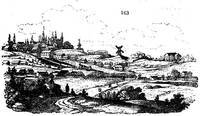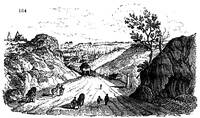489. Cemeteries. At Warsaw there is an old general cemetery, rich in tombs and monuments; also a new one, of great extent, in which a large portion of the ground is regularly trenched from one end to the other, as interments take place; and the calculation is, that ten years will intervene before the operation requires to be recommenced. In this cemetery, as in the others at Warsaw, a part of the boundary wall is built so thick and so high as to contain tiers of cells one above another, in which coffins are inserted endwise, and closed up by masonry, faced by commemorative tablets. There is a German cemetery, characterised by sentimental inscriptions, weeping willows, and cypresses; and the Jews, a persecuted people in this capital, as in most others in Europe, have a cemetery without the walls, covered, when we saw it, in 1813, with long grass, and a few trees. On entering the city of Wilna from Grodno, a large general cemetery is seen on the left (fig. 163.), on elevated irregular ground, displaying fine views of the town, and of the hills beyond. If this cemetery were judiciously planted, it would become one of the most picturesque in Europe. A cemetery was commenced on the high bank of the Niemen (fig. 164.), in 1812; but whether it has been proceeded with, we do not know. If judiciously planted, it would form a great ornament to the town, on approaching it from Tykochin and Bialystock.



